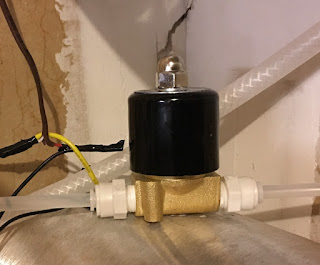The problem:
Instant hot water faucets do not come in the wall mount variety. Standard faucets can not be used because instant hot water heaters are designed to be open vent.
What is open vent?
Here is my understanding. Hot water heaters must have an emergency release valve if they are pressurized. This is expensive and messy. The instant hot water designers decided to design their heaters without an emergency release and instead keep the tank un-pressurized. This is done by having the open/close valve on the intake side of the heater and not having a valve at the faucet side. This way if the water boils in the tank it simply spurts out of the open faucet. There is never any pressure build up in the tank. So that is good, but there is a downside. The valve arrangement is not typical and only faucets designed with this complicated arrangement can be used. The cold water supply line goes to the faucet, hits the valve and then travels to the hot water heater and then back to the faucet out the spout with no further restriction.
How to design a DIY open vent faucet?
There are different ways of implementing this. I chose a solenoid actuated valve with a push button actuator operating with a low voltage transformer. The push button is normally open (NO) type and is mounted next to the spout.
Implementation:
 |
| Quick & Hot AH-1300 |
 |
| center is 3/8" outlet side is 1/4" inlet |
Inlet is standard 1/4" quick connect and plastic tubing
hot water heater
This shows the quick connect male adapters connected to the 1/4" female threads of the solenoid valve. The wires (electrical connection) can be seen behind it.
solenoid valve (1/4")
Silicone tubing for the hot water line from the hot water heater
Custom wall mount faucet with stainless steel push button and drip tray
The faucet has no valve on it, it is a curved section of 3/8" pipe. The stainless steel hot/cold/seltzer tower was designed and created by Craig at Willtec http://www.athomesoda.com.
I used 12 volt transformer and the push button and some wire to make the connections to actuate the solenoid valve.


No comments:
Post a Comment